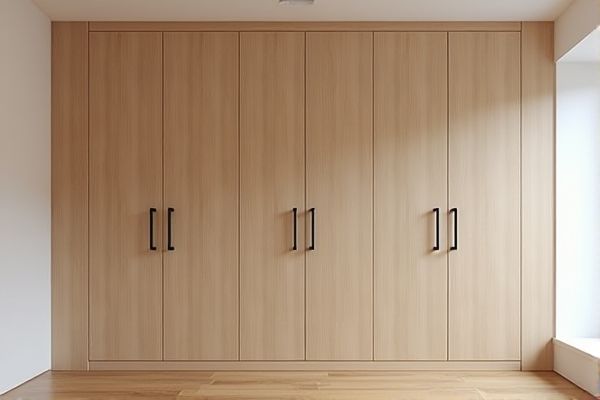
Melamine closets offer a durable, scratch-resistant surface that requires minimal maintenance, while plywood closets provide superior strength and natural wood aesthetics, often preferred for custom designs. Discover the key differences to choose the perfect closet material that suits Your storage needs and style by reading the rest of this article.
Table of Comparison
| Feature | Melamine Closet | Plywood Closet |
|---|---|---|
| Material Composition | Engineered wood with melamine resin coating | Layered wood veneer glued together |
| Durability | Scratch-resistant, moisture-resistant but less impact resistant | Strong, more impact and moisture resistant |
| Finish | Smooth, glossy or matte surface, consistent texture | Natural wood grain, can be polished or painted |
| Cost | Generally lower-priced | Higher cost due to quality material |
| Weight | Lighter than plywood | Heavier due to solid wood layers |
| Maintenance | Easy to clean, resistant to stains | Requires polishing and regular care |
| Environmental Impact | Uses synthetic coating, less eco-friendly | More eco-friendly with natural wood |
| Usage | Ideal for budget-friendly, stylish closets | Best for durable and high-end closets |
Introduction to Melamine and Plywood Closets
Melamine closets feature engineered wood panels coated with a durable resin laminate, offering a smooth, moisture-resistant surface ideal for modern storage solutions. Plywood closets consist of layers of wood veneers bonded together, providing superior strength, durability, and natural wood aesthetics. Choosing between melamine and plywood depends on factors like budget, desired finish, and long-term durability requirements.
Material Composition: Melamine vs Plywood
Melamine closets are constructed from engineered wood panels coated with a melamine resin film, offering a smooth, durable, and moisture-resistant surface ideal for modern storage solutions. Plywood closets consist of multiple thin layers of wood veneer glued together, providing superior strength, flexibility, and natural wood aesthetics but with less resistance to moisture compared to melamine. The choice between melamine and plywood hinges on the desired balance of durability, appearance, and moisture resistance in closet construction.
Aesthetic Appeal and Design Flexibility
Melamine closets offer a sleek, modern finish with a wide range of colors and textures that enhance contemporary interior aesthetics. Plywood closets provide superior design flexibility, allowing for intricate customizations such as curves, moldings, and paneling due to its workability. Both materials accommodate diverse design preferences, but melamine excels in uniformity and easy maintenance while plywood supports unique craftsmanship and traditional elegance.
Durability and Lifespan Comparison
Melamine closets offer a durable, scratch-resistant surface that resists stains and moisture, making them ideal for moderate use with a typical lifespan of 10 to 15 years. Plywood closets boast superior structural strength and resistance to warping or cracking, extending their durability and lifespan up to 20 years or more with proper care. Choosing between melamine and plywood affects your closet's longevity, where plywood generally provides a more robust and longer-lasting solution.
Cost Analysis: Melamine Closet vs Plywood Closet
Melamine closets typically cost less than plywood closets due to the lower material price and manufacturing process, making them a budget-friendly option for wardrobe construction. Plywood closets, although more expensive, offer greater durability, resistance to warping, and a higher-quality finish, which can justify the increased investment over time. Considering installation and maintenance expenses, melamine closets may incur higher repair costs due to susceptibility to chipping, whereas plywood closets provide longer-lasting value despite the upfront cost.
Maintenance and Cleaning Requirements
Melamine closets require minimal maintenance due to their smooth, non-porous surface that resists stains and moisture, making cleaning quick with just a damp cloth and mild detergent. Plywood closets, while sturdy, demand more frequent upkeep to prevent water damage and warping from exposure to moisture, often needing sealing or polishing to maintain durability. Regular dusting and avoiding harsh chemicals help preserve the finish and structural integrity of both materials, but melamine offers a more hassle-free cleaning experience overall.
Environmental Impact and Sustainability
Melamine closets are made from engineered wood panels coated with melamine resin, which can emit formaldehyde and pose challenges in recycling due to synthetic coatings. Plywood closets, constructed from thin layers of natural wood veneers bonded with adhesives, typically have lower formaldehyde emissions and offer better biodegradability, making them a more sustainable option. Choosing plywood contributes to reduced environmental impact by utilizing renewable wood resources and facilitating easier recycling and disposal.
Installation Process and Customization Options
Melamine closets offer a straightforward installation process due to pre-laminated panels that are easy to assemble and require minimal tools, making them ideal for quick setups. Plywood closets provide greater customization options through their ability to be easily cut, shaped, and painted, allowing tailored dimensions and finishes for unique storage needs. While melamine is resistant to scratches and stains, plywood supports advanced customization like intricate joinery and diverse surface treatments, enhancing both aesthetic and functional design flexibility.
Suitability for Different Room Types
Melamine closets are ideal for humid areas like kitchens and bathrooms due to their moisture resistance and easy-to-clean surface, while plywood closets excel in bedrooms and living rooms because of their durability and ability to hold heavy hardware. Your choice depends on the room environment: melamine suits spaces prone to moisture, whereas plywood performs better in dry, well-ventilated rooms. Both materials offer distinct advantages that align with specific functional and aesthetic needs.
Final Verdict: Choosing the Right Closet Material
Melamine closets offer a durable, moisture-resistant surface with ease of maintenance, making them ideal for humid environments and budget-conscious projects. Plywood closets provide superior strength, structural integrity, and a premium finish that holds screws and hardware better for long-term use. Selecting the right closet material depends on balancing factors like budget, environmental conditions, and desired longevity, with melamine excelling in cost-effectiveness and plywood in durability.
 homyna.com
homyna.com